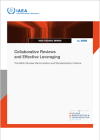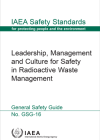Establishing a strong safety and security culture is one of the fundamental management principles for an organization dealing with radioactive material. Such a culture influences the organization’s structure and style, as well as the attitudes, approaches and commitment of individuals at all levels in the organization.
Safety and security culture
All activities involving the use of radioactive material require careful attention to safety and security. Safety is aimed at preventing accidents; security is aimed at preventing intentional acts that might harm the facility or result in the theft of nuclear materials.
Although these activities have a different focus, they overlap each other. Actions that are taken to further one activity can have implications for the others. Concerns about a radioactive release have long provided the justification for an emphasis on safety. In the aftermath of the 9/11 terror attacks and subsequent terrorist activities around the globe, operators, regulators and international organizations have all given increased attention to ensuring adequate security at facilities using radioactive material.
In-depth analyses of a number of radiation and nuclear accidents have shown that weaknesses in either (or both) safety and security culture were one of the foremost root causes of the accidents.
To understand the concepts of safety and security culture one must have insight into the overall notion of ’culture.’ Culture is to society what memory is to individuals. Culture includes traditions that reflect “what has worked in the past.” It also encompasses the way people have learned to look at their environment and themselves, and their unstated assumptions about the way the world is and the way people should act.
All organizations develop cultures of their own, as organizational members often share similar core values and attitudes. These values and attitudes also direct how members deal with safety and security, and thereby reinforce both positively and negatively the safety and security of the organization. In other words, in an organisation it is the way safety and security is perceived, valued, prioritised and integrated that reflects the strength of its safety and security culture. To emphasise the importance of organizational culture, the IAEA and others also refer to ’organizational culture for safety’ as a synonym for safety culture.
The IAEA defines a strong safety culture as the “assembly of characteristics, attitudes and behaviours in individuals, organizations and institutions which establishes that, as an overriding priority, protection and safety issues receive the attention warranted by their significance.” Similarly, the IAEA defines a strong security culture as the “assembly of characteristics, attitudes and behaviour of individuals, organizations and institutions which serves as means to support and enhance nuclear security.”
Assessing and understanding an organisation's safety and security culture can lead to understanding how safety and security performance can be supported and sustained, and also to identify vulnerabilities that can lead to a decline in performance and be a cause of failure.
The IAEA provides tools and training to Member States to assess, improve and strengthen the safety and security culture throughout the lifetime of their facilities and activities. This includes specific support services such as Independent Safety Culture Assessments (ISCA) and the Safety Culture Continuous Improvement Process (SCCIP), which includes training support on conducting safety culture self-assessments as well as support to implement the IAEA Safety Culture Self-Assessment methodology.
Finally, the IAEA offers a range of tailored support missions based on Member States’ needs.







